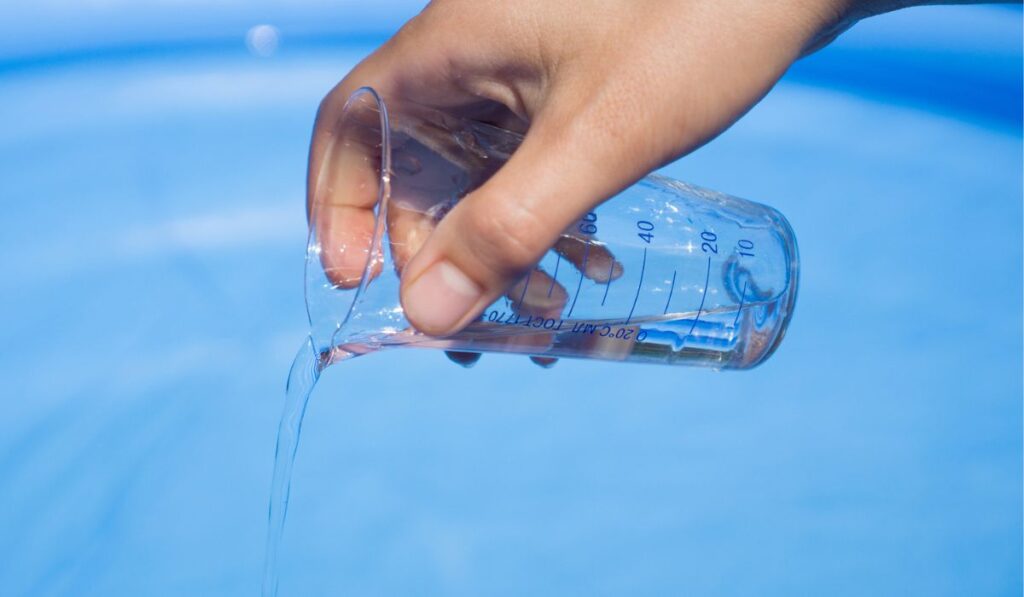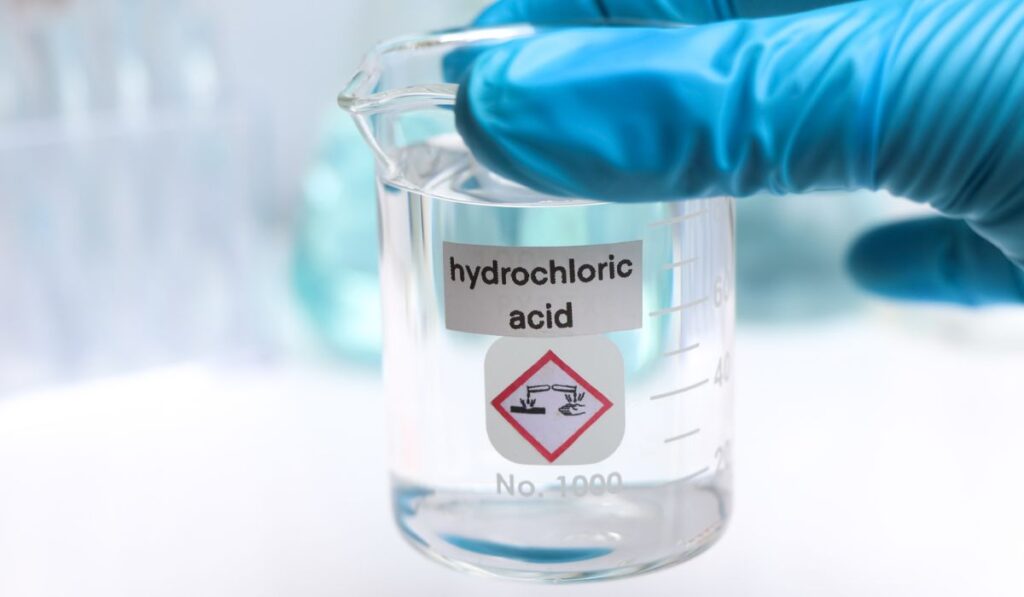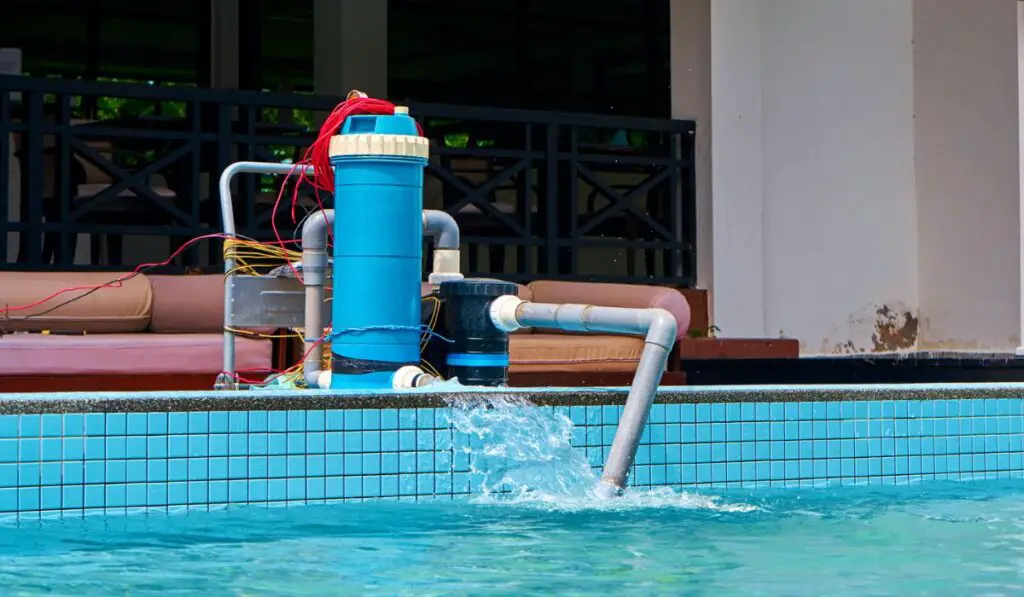If you have a swimming pool in your backyard, then you know how important it is to keep the chemistry of the water balanced. Because of this, you may find yourself needing to use muriatic acid from time to time.
While muriatic acid can be effective in lowering the pH levels of your pool, it can also wreak havoc on the tiled and cement surfaces if you use too much. Before adding it to your pool, test the pH levels and use a pool calculator to find the exact amount of muriatic acid that you should add.
Knowing how to use muriatic acid for the maintenance of your swimming pool can make the difference between keeping your pool’s chemistry balanced and causing irreparable damage. Let’s look at what muriatic acid is and how you should use it to help keep your pool in great working order.
What is Muriatic Acid?
When it comes to muriatic acid, it is important to understand that it is a more diluted form of hydrochloric acid. This means that if not used properly, it can cause a lot of damage to any surface it comes in contact with.
Since muriatic acid has corrosive properties, it works effectively to lower the pH levels in your swimming pool’s water. This means that if your water is out of balance and has very high levels, then adding muriatic acid can do wonders to lowering them.
Because muriatic acid is indeed an acid, although a diluted one, it can corrode the various parts of your swimming pool. Because of this, you should only use it if you have taken the time to learn just how to use it safely.
Why Would You Need to Add Muriatic Acid to Your Pool?

If you have a swimming pool in your backyard, then you know that there are times when the chemical balance can get out of control. There are specific steps that you can take to ensure that your pool stays as chemically balanced as possible.
Most pool owners know that one of the least expensive and easiest ways to keep the pH balance of your pool intact is to add muriatic acid. This is because it does a great job of balancing the water in your pool quickly.
It is important to understand that while it can be extremely damaging to your pool and guests for the water to be too acidic, it can also be dangerous to have high alkalinity. High alkalinity allows bacteria to grow in your pool, which could make guests ill.
Overall it is important to use muriatic acid in your swimming pool to help keep the chemical levels balanced. Since an unbalanced swimming pool can wreak havoc on the surroundings, muriatic acid can be used to bring it back to the balance it needs.
How Do You Test Your Pool’s Alkalinity?
There are several ways that you can test the alkalinity of the water in your backyard swimming pool. Whichever method you choose to use, it is important to keep in mind that testing the water regularly will ensure that the water stays balanced.
One way you can test the alkalinity of your pool’s water is to use test strips that you can purchase at any local pool supply store. While test strips(on Amazon) are not the most accurate, they are often used to take quick measurements.
Another more effective way to test the alkalinity in your swimming pool is to use a digital testing kit(on Amazon). These kits give you a more accurate reading of the alkalinity levels and can be tested quickly when you are adding in your muriatic acid.
Keep in mind that the most recommended levels for your pool should be for pH to be between 7.4 and 7.8. The alkalinity levels should be between 100 to 160 ppm or parts per million for it to be more balanced.
Muriatic Acid vs Hydrochloric Acid: What’s the Difference?

For those who are curious about the differences between muriatic acid and hydrochloric acid, it is important to know how similar they are. They are both forms of acids, so using either of them should be done so with caution.
Hydrochloric acid is a highly corrosive acid that is used to neutralize the alkalinity in certain types of water. Used in various industries for a variety of purposes, hydrochloric acid, like other acids, requires the use of caution.
Muriatic acid, which is most commonly used to lower the pH levels in your backyard swimming pool, is a more diluted solution. This means that while it is still an acid, it is less pure, which can be considered a bit safer for consumer use.
How Long Do You Have to Wait to Swim After Adding Muriatic Acid to Your Pool?
Another question that is often asked about the addition of muriatic acid to a swimming pool is how long you have to wait before you can swim again. It is important to understand the answer to this question will depend on whether or not you get the levels balanced correctly.
You will need to ensure that you have checked the pH and alkalinity levels after each application of the muriatic acid. Doing so will ensure that the levels are brought back down to the recommended numbers.
Once the swimming pool’s water is balanced, it is important to let the water flow and run in and out of filters multiple times before you go back in. This is because muriatic acid tends to pool in various areas and can cause hot spots.
These hot spots can be extremely dangerous for people if they run across them. In most cases, the hot spot of acid can cause your skin, eyes, throat, and nose to burn and become irritated. Some cases have the tendency to be worse than others, depending on how much acid was in the hot spot.
Because of the danger of muriatic acid coming in contact with individuals, you need to wait for at least an hour after the application. Keep in mind that the longer you wait to go into the pool after muriatic acid has been applied, the safer it is.
How to Add Muriatic Acid to Your Pool
When it comes to adding muriatic acid to your swimming pool after the alkalinity is too high, it is important to follow a few specific steps. These steps can save you quite a bit of time and ensures that you are not causing more damage to your pool.
Keep in mind that the best rule of thumb is to ensure that you are following the manufacturer’s instructions first and foremost. This will keep you and those that may also use the pool in the safest condition possible.
Wondering just how to add muriatic acid to your pool? Keep reading to find out.
Test Your Pool’s pH and Alkalinity Levels
The first step you should take before adding muriatic acid to your swimming pool is to test the chemical levels in the water. You can purchase a variety of tools to do this at your local pool supply store.
While some people prefer to use test strips for both convenience and the fact that they are less expensive, others prefer to use digital sensors. Keep in mind that digital sensors are much more accurate than test strips.
When testing the chemical balance in your swimming pool, it is important to understand what the levels should be. You will want to ensure that both the pH and alkalinity levels are balanced for the best results.
Here are the levels you should strive for:
- pH levels should fall between 7.4 and 7.8
- Alkalinity levels should be between 100 to 160 ppm (parts per million)
It is important to note that your chemical levels should be checked regularly as a part of your daily maintenance routine. This will prevent the pool’s chemistry from being out of balance and make it safer for all swimmers.
Calculate the Amount of Chemicals You Need to Add
Once you have tested your pool’s chemical balance, you will have a better idea of how much muriatic acid you will need to add. For best results, it is recommended that you use a pool calculator so you do not add too much or too little.
The first thing you will need to know is the volume of water your pool holds overall. This will help you to accurately measure the amount of muriatic acid you will need to add.
Keep in mind that it is better to add too little at first and then retest to ensure that you do not add too much. Adding too much will cause the pH and alkalinity levels to drop too low which will mean you have to add more chemicals to balance it.
Put on Protective Gear
After you have calculated the amount of muriatic acid you need to add to your pool, you will need to put on protective gear before you start. Keep in mind that muriatic acid can harm you if you get it in your eyes or on your skin.
Experts recommend that you wear goggles, gloves, protective clothing, and a mask to keep the acid from getting on you in any way.
Turn on the Pool Pump

Turning on the pool’s pump before you add in the muriatic acid allows the water to flow, thus mixing the acid around. This will ensure that every part of the water in the pool is treated and balanced accordingly.
Dilute and Add the Muriatic Acid
Before you add muriatic acid to your swimming pool, it is recommended that you first dilute it in a bucket. This is because of the corrosive nature of the acid and the potential for damage to your pool’s surfaces.
Once the muriatic acid is diluted according to the manufacturer’s recommendations, it is time to start adding in your chemicals. It is best to add the muriatic acid slowly to allow it to begin circulating before adding more.
Allow to Circulate and Retest
Most pool experts recommend that you allow the muriatic acid to circulate for several hours before you retest. This allows it enough time to reach all parts of the water, thus creating a proper balance.
Once you have allowed it to circulate for a few hours, you will need to retest the pool’s chemical balance to ensure that it is back to recommended levels. If you find that it is not, then you will need to add more chemicals to reach the results you are looking for.
Final Thoughts About What Muriatic Acid Does to Your Pool
Overall when it comes to muriatic acid in your swimming pool, it works wonders in bringing the alkalinity levels to recommended amounts. Keep in mind that you will need to take certain precautions, but you will have a balanced pool that is safe for everyone to swim in.
